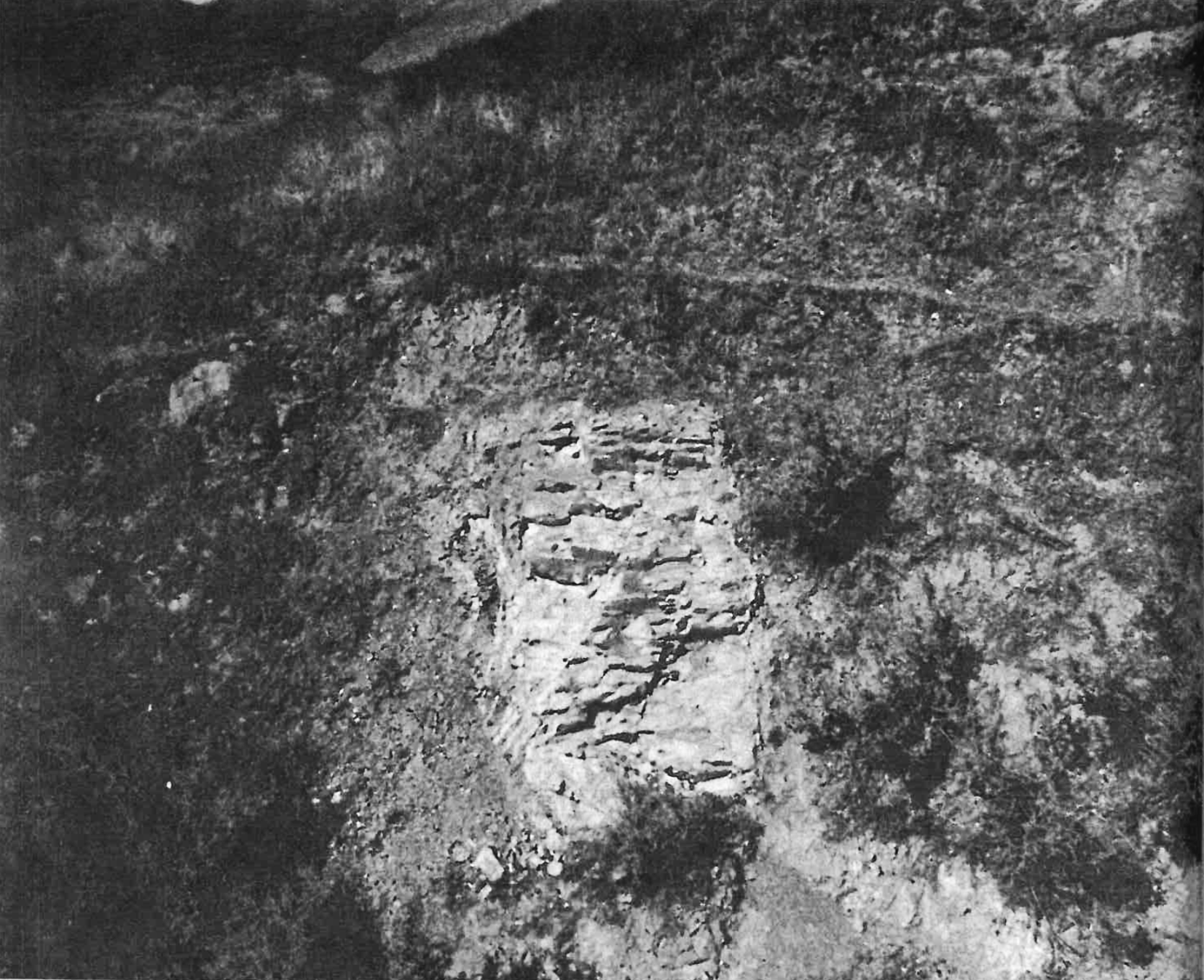©Copyright 2018 GEOSCIENCE RESEARCH INSTITUTE
11060 Campus Street • Loma Linda, California 92350 • 909-558-4548

CLASTIC DIKES
by Ariel A. Roth
Geoscience Research Institute
Related page | REACTION |
The sediments that cover the surface of the earth are usually laid down in a horizontal or near-horizontal position and frequently remain that way. Occasionally within these layers are somewhat vertical cracks filled with different kinds of sediments. These vertical foreign bodies of sediments penetrating the horizontal sedimentary layers are called clastic dikes (Figure 1). The size of the dikes can vary in thickness from a few centimeters to hundreds of meters; their height is usually several times greater than their width. Often the sediments in the dikes come from other sediments found below the intruded layers. The process of formation is analogous to wet sand oozing up between one's toes, only on a larger scale.

FIGURE 1. Portion of a clastic dike located in the Panoche Hills on the west edge of California's Great Valley. The dike which consists of hard sandstone is the nearly vertical, lighter-colored rock unit found in the lower central part of the picture. It is about 1 meter wide. On either side and above lies the softer Late Cretaceous Moreno Shale largely covered by a thin layer of vegetation.
Clastic dikes pose time constraints for the two deposits forming them, because the lower layer which furnishes the sediment for the dike must have remained uncemented while the upper intruded layers were laid down. Subsequent pressure forced the still-soft sediments below into the crack in the firmer upper deposits. In the context of the long ages assumed for geologic time, the intruded sediments (above) and the intruding ones (below) are considered to have formed at approximately the same time. Such units are designated as penecontemporaneous (i.e., formed before consolidation).
Clastic dikes are a peculiar but not unusual occurrence (Shrock 1948, pp. 212-221, Newsom 1903). Found throughout the geologic column, large numbers of them have been described in the Cretaceous and Tertiary. About 500 have been noted in central and northern California (Peterson 1968, Smyers and Peterson 1971). Ten thousand are reported in Japan from Permian to Pleistocene with the majority being in the Miocene (Hayashi 1966).
One series of dikes of special interest to one seeking to determine the age of sediments in the earth is found in the Front Range of Colorado north of Pikes Peak (Gross 1894, Roy 1946, Vitanage 1954, Harms 1965). In this case, sand from the Cambrian Sawatch sandstone has intruded into the Precambrian Pikes Peak granite during the Laramide Orogeny. This orogeny is the main uplift forming the Rocky Mountains which occurred relatively late in geologic time. There is disagreement as to whether the intrusions forming these dikes are from below or from above; in this case the time discrepancy is so great that this point makes little difference. The sandstone dikes contain fragments from the Permian-Pennsylvanian Fountain Formation, indicating that at least this formation was present at the time of intrusion. On a geologic time scale this represents a period of at least 250 million years during which the Sawatch sandstone remained uncemented. This seems especially unusual since just above the Sawatch are several carbonate layers that could provide an abundant source of cement for the Sawatch. If, as field evidence indicates, intrusion took place during the Laramide Orogeny, the Sawatch sandstone would have had to remain uncemented for more than 400 million years. On the other hand, if, as expected, dikes are formed at approximately the same time as their host rock, or at least the cracking of the host rock during the Laramide Orogeny in the Pikes Peak granite case, then there must not be much time difference between the Cambrian and the Laramide Orogeny which supposedly occurred more than 400 million years later!
REFERENCES
- Cross, Whitman. 1894. Intrusive sandstone dikes in granite. Geological Society of America Bulletin 5:225-230.
- Harms, John C. 1965. Sandstone dikes in relation to Laramide faults and stress distribution in the southern Front Range, Colorado. Geological Society of America Bulletin 76:981-1002.
- Hayashi, Tadaichi. 1966. Clastic dikes in Japan (I). Japanese Journal of Geology and Geography, Transactions and Abstracts 37:1-20.
- Newsom, F.J. 1903. Clastic dikes. Geological Society of America Bulletin 14:227-268.
- Peterson, Gary L. 1968. Flow structures in sandstone dikes. Sedimentary Geology 2:177-190.
- Roy, Chalmer J. 1946. Clastic dikes of the Pikes Peak region. Abstract. Geological Society of America Bulletin 57:1226.
- Shrock, Robert R. 1948. Sequence in layered rocks. McGraw-Hill Book Co., New York.
- Smyers, Norman B. and Peterson, Gary L. 1971. Sandstone dikes and sills in the Moreno Shale, Panoche Hills, California. Geological Society of America Bulletin 82:3201-3208.
- Vitanage, P.W. 1954. Sandstone dikes in the South Platte area, Colorado. Journal of Geology 62:493-500.